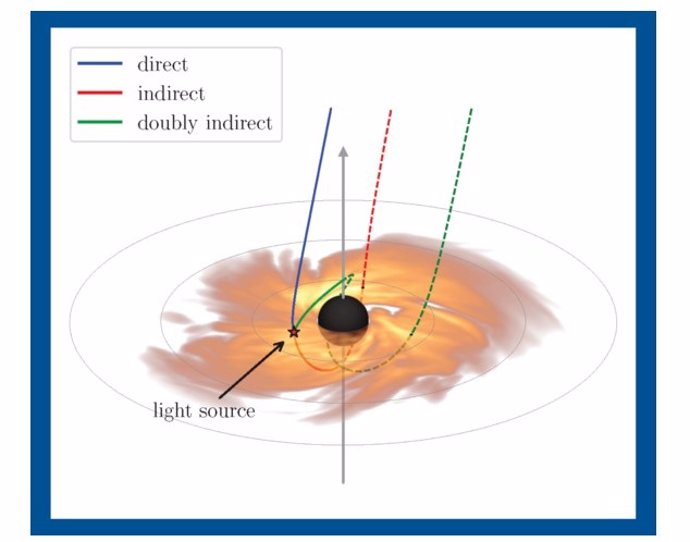Due to the gravitational lensing effect, photons from a single flash of light near a black hole follow sinuous paths. – GEORGE N. WONG
Nov. 8 () –
Astrophysicists have developed a innovative technique to search for light echoes from black holes, which works independently of how scientists have investigated these parameters in the past.
The novel method, which will facilitate the measurement of the mass and spin of black holes, has been published in The Astrophysical Journal Lettersand could provide direct evidence of photons orbiting black holes due to an effect known as “gravitational lensing.”
Gravitational lensing occurs when light passes near a black hole and its path is deflected by the black hole’s strong gravitational field. The effect allows light to take multiple paths from a source to an observer on Earth: some light rays can follow a direct path while others can circle the black hole one or several times before reaching us. This means that Light from the same source can arrive at different times, resulting in an “echo.”
“It has been theorized for years that light rotates around black holes and produces echoes, but these echoes have not yet been measured,” he says. in a statement the study’s lead author, George N. Wong, a scientist at the Institute for Advanced Study and a research associate at the Princeton Gravity Initiative at Princeton University. “Our method offers a model for making these measurements, which “could potentially revolutionize our understanding of the physics of black holes.”
The technique allows weak echo signals to be isolated from the more intense direct light collected by well-known interferometric telescopes, such as the Event Horizon Telescope. Both Wong and one of her co-authors, Lia Medeiros, a NASA Einstein Fellow at Princeton University, have worked extensively as part of the Event Horizon Telescope Collaboration.
To test their technique, Wong and Medeiros, in collaboration with James Stone, a professor in the School of Natural Sciences, and Alejandro Cárdenas-Avendaño, a Feynman Fellow at Los Alamos National Laboratory and former research associate at Princeton University, ran simulations high-resolution images that took tens of thousands of “snapshots” of light traveling around a supermassive black hole similar to the one found at the center of the M87 galaxy (M87 star), which is located about 55 million light years from Earth.
Using these simulations, the team demonstrated that their method could directly infer the echo delay period in the simulated data. They believe their technique will be applicable to other black holes in addition to star M87.
“This method will not only be able to confirm when the light orbiting a black hole has been measured, It will also provide a new tool to measure fundamental properties of the black hole.“explains Medeiros.
Understanding these properties is important. “Black holes play an important role in shaping the evolution of the universe,” says Wong. “Although we often focus on how black holes attract things, They also expel large amounts of energy into their surroundings.
“They play an important role in the development of galaxies, affecting how, when and where stars form, and helping to determine how the structure of the galaxy itself evolves.” Knowing the distribution of masses and spins of black holes , and how this distribution changes over time, “greatly improves our understanding of the universe.”
Measuring the mass or spin of a black hole is complicated. The nature of the accretion disk, that is, the rotating structure of hot gas and other matter that spirals into the black hole, can “confound” the measurement, Wong notes. However, light echoes provide an independent measurement of mass and spin, and having multiple measurements allows us to produce an estimate of those parameters. “which we can really believe in”, Medeiros says.
Detecting light echoes could also allow scientists to better test Albert Einstein’s theories of gravity. “Using this technique, we could find things that make us think ‘Hey, this is weird!’“Adds Medeiros. “The analysis of this data could help us verify whether black holes are really consistent with general relativity.”
The team’s results suggest that it may be possible to detect echoes with a pair of telescopes, one on Earth and one in space, working together to perform what can be described as “Very Long Baseline Interferometry,” says Wong. Such an interferometric mission only has to be “modest,” he says. His technique provides a manageable and practical method to collect important and reliable information about black holes.




![[Img #74662]](https://thelatestnews.world/wp-content/uploads/2024/12/Organisms-with-the-shortest-life-150x150.jpg)








![[Img #74662]](https://thelatestnews.world/wp-content/uploads/2024/12/Organisms-with-the-shortest-life-300x200.jpg)


Add Comment